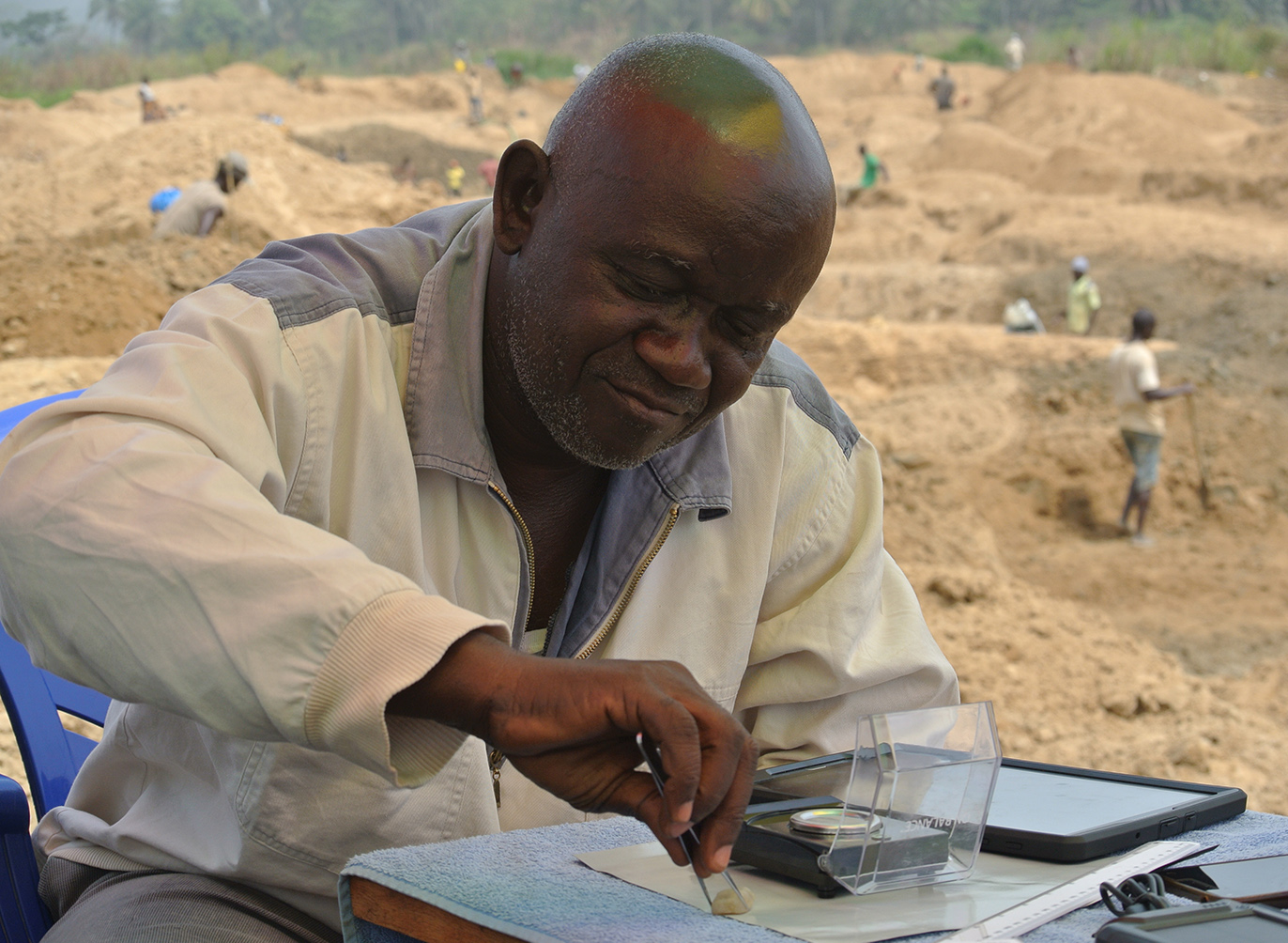GEMFAIR PROJECT IN SIERRA LEONE AIMS
TO POSITIVELY ‘IMPACT’ ARTISANAL MINING COMMUNITIES

ABOVE: An artisanal miner in Sierra Leone’s Kono region weighing a diamond, using the electronic scale that is supplied as part of the GemFair toolkit.
“Impact” is a very loaded term when it comes to discussing the effects of mining. Too often it is applied negatively, referring to elements like conflict diamonds, particularly in the developing world. But the recovery and trade of minerals, and diamonds in particular, can have an altogether different “impact.”
The vast majority of the world’s diamond production comes from large, well-established operations that have stringent labor, social and environmental policies and programs in place. The economic benefits delivered by these mines in the countries in which they operate are considerable, and in a number of producing nations absolutely essential. In fact, a recent report conducted on behalf of the Diamond Producers Association (DPA), which looked at the impact on the economies and society in the countries in which the organization’s seven member-companies operate, showed they deliver $16 billion worth of net benefits annually.

The GemFair team posing outside the De Beers buying office in Sierra Leone’s Kono region, on the day that project registered its first rough diamond purchase.
While the DPA members, who collectively represent around 75 percent of global diamond production, employ about 77,000 workers and contractors globally, between 1 million and 1.5 million individuals are involved in artisanal diamond mining, predominantly in Africa, but also in South America. Accounting for around 15 percent of all rough diamonds produced each year by volume, they only receive 5 percent of the revenue in terms of value.
The challenges faced by artisanal miners are daunting. Using only rudimentary equipment in undeveloped and often remote areas of the world, they frequently are uninformed about the real market value of the goods they have recovered, and therefore are particularly vulnerable to exploitation. This is compounded by the difficulties they experience in accessing the legitimate diamond pipeline and obtaining Kimberley Process (KP) certification.
Speaking during a Special Forum at the KP Intersessional Meeting on June 19, Feriel Zerouki, a WDC Board member and Senior Vice President of International Relations and Ethical Initiatives at De Beers Group, provided an overview of a pilot project initiated in Sierra Leone, which uses a digital solution to provide artisanal and small-scale miners with a secure route to market for ethically-sourced diamonds, while at the time helping them to receive fair market value.
Called GemFair, the project was launched in 2018 in the Kono region of the country, and immediately started to provide services to registered artisanal miners at 14 carefully demarcated sites, which have been certified as compliant with the Maendeleo Diamond Standards (MDS) by the Diamond Development Initiative (DDI).
The Maendeleo Diamond Standards are an innovative certification system that enables ethical production of diamonds by artisanal and small-scale mining operations, through the adoption of eight specific principles covering legality, consent and community engagement, human and worker’s rights, health and safety, violence-free operations, environmental management, interactions with large-scale mining and site closure. Maendeleo is a Swahili word meaning “development.”
Since its launch in April 2018, GemFair has increased the number of member mine sites it works with from 14 to 72, between September 2018 and June 2019. Out of these 72 mine sites, 14 are now fully MDS-certified. The other 58 have been assessed to meet a set of minimum requirements, which are closely aligned with the Material Breaches of the De Beers Group Best Practice Principles Assurance Program and the OECD’s Due Diligence Guidance. Some 36 are on track to be trained by DDI and acquire MDS certification and the remaining 22 are being trained by GemFair.


GemFair staff training artisanal miners both in the project’s offices and in the mining area.
As part of the program, GemFair supplies certified miners with a dedicated tool kit free of charge. It contains basic gemological equipment, including a loupe and scale, QR-coded sealable bags and a weatherproofed tablet computer, which is a designed to operate in the often-unforgiving conditions at the artisanal mining sites and comes equipped with a solar charger.
When artisanal miners recover a diamond, they use an application on the tablet computer to register the stone, providing basic gemological information, and uploading photographs both of the rough diamond and the miner holding it. The first set of photographs are intended to assist the GemFair staff with the traceability assurance function of the digital solution, and the second set is to verify the identity of the miner. Using GPS location technology, GemFair is able to ascertain that the stone has been recovered in a certified artisanal mining site.
The miner delivers the diamond in a QR-coded bag to the GemFair buying office where it is valued by GemFair’s experienced diamond buyers, then an offer is made. If the miner accepts the offer, payment is prompt. Miners in the program are not obliged to sell their merchandise to GemFair, but even if they do not they have been provided valuable information about the market value of diamonds in their possession.
Rough diamonds purchased by GemFair and exported from Sierra Leone are KP-certified, and eligible to be traded legally in the major markets. They also can be traced individually to the artisanal mine sites at which they were recovered. De Beers Group plans on integrating them into its Tracr blockchain, which will provide a full chain of custody all the way through to the final buyer.
If the project in Sierra Leone is deemed successful, De Beers Group intends to introduce GemFair to other countries. While currently exclusively dedicated to diamonds, the company believes that by tweaking the system it can also be applied to artisanal mining of other minerals.
This article is the first in an ongoing series featured in the WDC News Update newsletter, featuring grass-roots capacity-building and sustainability programs initiated by WDC members to support communities where diamonds are mined, processed and traded.






